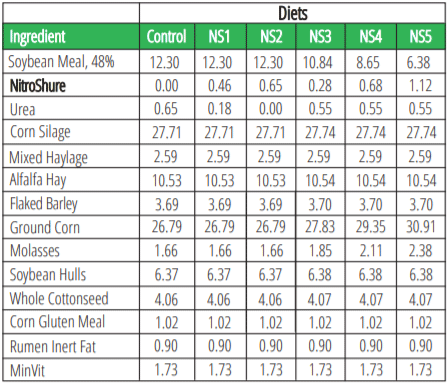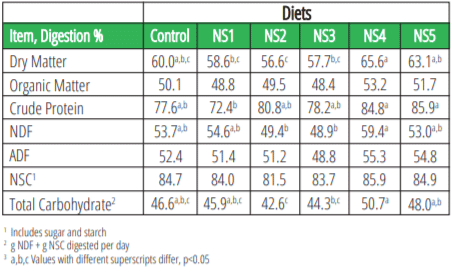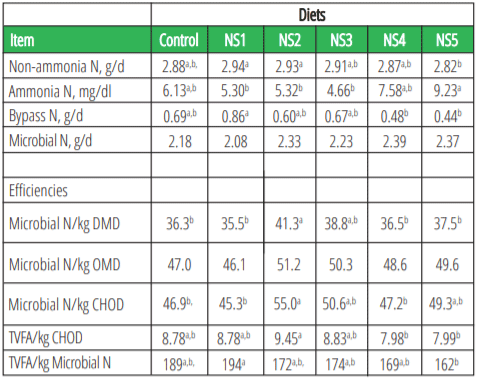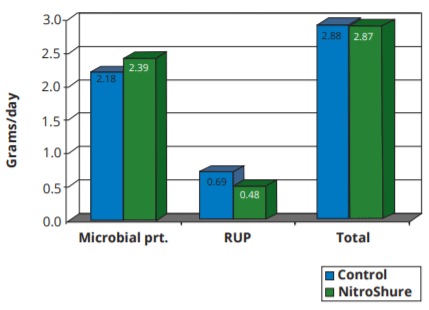
Content sponsored by:
Balchem Animal Nutrition
Effects of the Addition of NitroShure to Lactating Cow Diets on Microbial Efficiency and Metabolism in Continuous Culture of Rumen Contents
Published: October 18, 2021
By: A summary of a study conducted by J. Garrett.
Background
Reducing the rate at which ammonia is released from urea into the rumen may allow rumen bacteria to more effectively capture the nitrogen released. Slowing the rate of release of ammonia from urea can be accomplished by encapsulating it with lipids. NitroShure Precision Release Nitrogen uses Balchem’s proprietary encapsulation technology to provide a more consistent nitrogen supply to rumen microbes, maximizing microbial protein yield, improving dry matter and carbohydrate digestibility while providing greater flexibility in formulating high performance dairy rations.
This study was designed to look at the effects of NitroShure replacement strategies in lactating cow diets on microbial growth and efficiency as well as digestibility of dietary components in continuous culture systems.
Materials and Methods
Lactating dairy cow diets were formulated using CPM and were balanced for a cow producing 100 pounds of milk per day. There were six experimental diets (Table 1). The Control diet contained 12.30% soybean meal (48% CP) and 0.65% urea with a total CP of 17.3%. In diets NS2 and NS3, NitroShure replaced 72% and 100%, respectively, of urea in the diets. In diets NS3, NS4 and NS5 urea was set at 0.55% of DM. Soybean meal was then replaced by NitroShure on an equivalent nitrogen basis. The percentages of soybean meal and NitroShure were: 10.84, 0.28; 8.65, 0.68 and 6.38, 1.12, respectively for diets NS3, NS4 and NS5. This would represent an approximate feeding rate of 68 g/h/day of NitroShure in NS3, 168 g/h/day in NS4 and 277 g/h/day in NS5. In diets NS3, NS4 and NS5 molasses and ground corn were added to make up for sugars and starch removed as soybean meal was replaced with NitroShure. The composition of the diets is shown in Table 2.
Table 1. Diet Composition, Dry Matter %

Table 2. Diet Analysis, Dry Matter %

Conditions used in the continuous cultures were: liquid dilution rate, 13.0%/hr; solids dilution rate, 4.5%/hr; solids retention time, 22 hr; feed intake 100 g DM/day and feeding frequency, 4 times per day every 6 hours. The fermentation temperature was 39⁰C. Each diet was fermented in triplicate using 9-day fermentations with effluent composited during the last 3 days of the fermentations. The pH of the cultures was monitored every half-hour. Data were analyzed using General Linear Model Procedures of SAS and a Duncan’s Multiple Range Test was used to compare individual treatment means.
Results and Discussion
Partial or complete replacement of urea with NitroShure did not significantly affect digestibility of dietary components (Table 3, Control vs. NS1 and NS2). However, in the diet where urea was completely replaced by NitroShure (NS2) DM digestibility tended to decrease. This appeared to be related in part to a reduction in NDF digestibility. While not significant, NSC digestibility also tended to be lower when urea was completely removed from the diet, which combined with lower NDF digestibility, resulted in a tendency for lower total carbohydrate digestibility. This may suggest that retaining at least small amounts of urea in diets might be warranted.
Table 3. Digestion Coefficients for Dry and Organic Matter, Crude Protein, Fiber and Nonstructural Carbohydrates

The results of partial replacement of soybean meal with a NitroShure, corn and molasses mix are shown in Table 3 (Control vs. NS3, NS4 and NS5). Dry matter, organic matter, NDF, ADF, NSC and total carbohydrate digestibilities were all highest for diet NS4 although not statistically different from the control. Crude protein digestibility was highest in NS5. Dry matter, organic matter, NDF, ADF, NSC and total carbohydrate all tended to decrease as higher levels of soybean meal were replaced by NitroShure (NS4 vs. NS5). Fermentation pH was not significantly affected by diet (data not shown).
The effects of diet on nitrogen portioning and microbial growth and efficiencies are shown in Table 4. Replacing urea with NitroShure tended to lower ammonia nitrogen relative to the control although the differences were not significant. When NitroShure partially replaced soybean meal, rumen ammonia levels increased. Satter and Slyter (1974) reported that rumen ammonia levels of approximately 6.1mg/dl were adequate for maximal microbial activity. However, others (Reynal and Broderick, 2005; Boucher et al., 2007) have reported improved animal performance and/or microbial activity at higher levels of rumen ammonia. The replacement of soybean meal with NitroShure increased rumen ammonia levels compared to the control particularly in the NS4 and NS5 diets. These diets also exhibited the highest digestibilities of dry matter, organic matter, protein, NDF, ADF and total carbohydrates. Partial replacement of soybean meal with NitroShure tended to numerically increase microbial yield compared to the control diet. Microbial efficiencies were generally higher when NitroShure replaced some soybean meal in the diets compared to the control, albeit not significantly higher. When NitroShure replaced SBM, efficiencies of carbohydrate use were maintained, similar to those on the control diet, while other efficiencies such as TVFA/kg carbohydrate digested and TVFA/kg microbial N were improved, showing that NitroShure was at least as effective as SBM in promoting use of nutrients for microbial growth rather than conversion to VFA.
Table 4. Nitrogen Partitioning, Microbial Growth and Microbial Efficiency

Efficiency of microbial growth, (g microbial N/kg carbohydrate digested) was highest when NitroShure replaced all the urea in the diet (NS2). This suggests that NitroShure was superior to urea in promoting conversion of digested carbohydrate to microbial mass. A large decrease in VFA produced/kg microbial N on this treatment support this contention.
Replacing 72 to 100% of urea with NitroShure reduced rumen ammonia levels. The slow release rate of ammonia from NitroShure appeared to have provided inadequate ammonia to support maximum nutrient digestion particularly when all urea was removed from the diet. On a practical basis this would suggest that when incorporating NitroShure into diets attention must be paid to maintaining adequate soluble protein levels in the diet.
Partial replacement of SBM with NitroShure resulted in increased rumen ammonia levels, which appears to have improved nutrient digestibility. Microbial metabolism and growth were improved over that of the control when up to 0.68 g/100g diet DM as NitroShure replaced 3.65 g SBM/100 g diet DM (NS4). There was no benefit to replacement of greater amounts of SBM with NitroShure. This may result from an excessive decrease in rumen peptide levels associated with feeding less SBM. Soybean meal is a good source of peptides. In diet NS4, in which 0.68 g NitroShure/100 g DM replaced 3.65g SBM, total NAN flow was maintained equal to that of the control. Although equal in quantity, the composition of the NAN in the control and NS4 differed (Figure 1) with diet NS4 providing more high quality microbial protein.
Replacing SBM with NitroShure, a highly concentrated source of nitrogen, has the added advantage of creating space in the diet. This space can then be filled with other ingredients that can improve the overall quality of the ration. In this study, removal of 3.65 % of SBM DM permitted the inclusion of a greater quantity of starch and sugar, which was efficiently used by the microbes.
Figure 1. Impact of Replacing Soybean Meal with a Mixture of NitroShure, Corn and Molasses (Diet NS4 on Non-ammonia Nitrogen Flow.

Conclusions
- Replacing all urea with NitroShure tended to decrease DM and NDF digestibility. Urea supplies fast ammonia which matches up with fast sugars and starches. It is possible that replacing all urea with NitroShure may have resulted in inadequate fast ammonia in early fermentation and thus tending to lower overall digestibility.
- NitroShure successfully replaced SBM resulting in numerically increased digestibility of DM, crude protein, NDF, ADF and total carbohydrate. In addition microbial yield and efficiency were higher when NitroShure replaced a portion of SBM. This may have resulted from NitroShure increasing rumen ammonia relative to SBM and thus stimulating bacterial growth.
- Substituting 0.68 g NitroShure for 3.65 g SBM (185 g per kg) gave the best overall response in this study.
- Replacing SBM with the more concentrated N source NitroShure creates space in the dist that can be filled with other ingredients that improves overall ration quality.
References
Boucher, S. E., R. S. Ordway, N. L. Whitehouse, F. P. Lundy, P.J. Kononoff and C. G. Schwab. 2007. Effect of incremental urea supplementation of a conventionalcorn silage-based diet on ruminal ammonia concentration and synthesis of microbial protein. J. Dairy Sci. 90:5619-5633.
Satter, L. D. and L. L. Slyter. 1974. Effect of ammonia concentration on rumen microbial protein production in vitro. Br. J. Nutr.32:199–208.
Reynal, S. M. and G. A. Broderick. 2005. Effect of dietary level of rumen-degraded protein on production and nitrogen metabolism in lactating dairy cows. J. Dairy Sci. 88:4045–4064.
Related topics
Authors:
Join to be able to comment.
Once you join Engormix, you will be able to participate in all content and forums.
* Required information
Would you like to discuss another topic? Create a new post to engage with experts in the community.
Create a post
.jpg&w=3840&q=75)